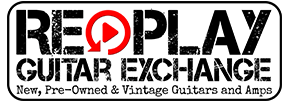The Mystery of MAP Revealed
Posted by Cliff Feldman on

Have you ever noticed that, when shopping for guitars on-line, most stores have exactly the same price? Is it simply a coincidence? Or is there price-fixing going on? Why wouldn’t one retailer lower their price a little to get more sales? I can answer these questions with three letters: M. A. P.
Back in the good ol’ days (before the Internet), instrument manufacturers established a “list” price for each product. The list price was important for several reasons: 1) It served as an MSRP or sticker price for the guitar. 2) The dealers cost is based on a percentage of list price. Back in those glorious days, most customers actually paid full List price. If a dealer wanted to offer a little discount to a good customer, there was plenty of profit margin available to do so. The store made a decent profit and everything was good. Then, the Internet came along.
As competition heated up from big-box mega stores and on-line retailers, there was tremendous pressure on stores to reduce prices. Retailers dropped their prices increasingly lower than List price to stay competitive. As a consumer, you might think, “Great! I like low prices, what’s the problem?”. From a retailers point of view, the prices became so close to dealer cost, that it was extremely difficult to earn a profit. Unable to survive on razor-thin margins, many stores went out of business. From the Manufacturers point of view, the extreme price cuts seemed to cheapen their brand and make it seem less valuable, so they implemented a new policy to fix it.
Most instrument manufacturers now have a Minimum Advertised Price (MAP) policy in effect. They can’t come right out and tell dealers what they have to charge –that would be price-fixing. Instead, manufacturers forbid a dealer to advertise their product below a certain price. This includes listing it for sale on a website as well as traditional advertising methods. This MAP price is much lower than List, but still ensures a reasonable profit margin for the retailer. If a dealer breaks the MAP policy, it risks losing access to that brand of products. And what about List price? Well, it’s mostly an imaginary number at this point, used only as a basis to calculate the dealer cost and MAP. Fender has actually done away with it completely and no longer publishes a List price.
Overall, I think MAP is a good thing. Without it, prices would fall to the point where only the most efficient on-line sellers could continue to carry them. Imagine if the only place you could buy a guitar was Amazon.com... I don’t want to live in a world like that! The best way to buy a guitar is to drive to your local store and hold the guitar in your hands, play it, and see how it feels. MAP allows local, independent shops like Replay to remain competitive on price with the giant on-line retailers and big-box stores.
And now, Dear Reader, you know what MAP stands for. I hope you found it enlightening. Remember: Next time you are shopping on-line for a guitar –turn off your computer and come to our store instead! We have an incredible selection and knowledgeable staff to help you find the perfect guitar for your needs. As usual, I’ll leave you with a Rock & Roll quote:
“When there's so much left to do, why spend your time focusing on things you've already done, counting trophies or telling stories about the good old days?” -Dave Grohl
Share this post
0 comment



